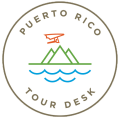American Rain Forest

The blue-gray cobblestone streets of Old San Juanare scorching hot, searing the bottoms of sandals like skillets cooking bistec encebollado — steak and onions. Some 30 miles east, however, the ground is cool and damp. Here, thousands of trees form a verdurous parasol that blankets the earth in shade.
It’s not just the temperature that’s different in this slice of Puerto Rico, however. It’s the ethos. Instead of colorful colonial architecture, these vistas burst with brightly colored blooms, including bright pink impatiens and red orchids. Instead of chlorinated swimming pools, there are refreshing waterfalls. And instead of traffic, the air echoes with sounds of San Pedritos — tiny, plump green birds that exhale distinctive “beeps” from their long, needle-nosed beaks.
Welcome to El Yunque National Forest, the only tropical rain forest in the U.S. National Forest System.
Encompassing more than 29,000 mountainous acres in northeast Puerto Rico, the area that is now El Yunque was sacred to indigenous people, who believed it to house one of their deities, the good spirit Yokahú. It remains sacred today — albeit for scientific instead of spiritual reasons. Celebrated for its biodiversity, the forest houses 240 native tree species, 50 varieties of native orchids, more than 150 species of ferns, 50 types of birds, 11 species of bats, eight kinds of lizards and 13 species of coquí, or tree frogs, whose nocturnal, birdlike chirping echoes through the trees each night like a Puerto Rican lullaby.
“We have a lot fewer species than, say, the Amazon, but 20 percent of the species we do have are endemic —meaning they don’t exist anywhere else,” notes El Yunque tour guide John “Rubio” Druitt of Rubio’s Tours.
That makes Puerto Rico in general — and El Yunque in particular — a hotbed for ecological research. And for tourism.
“El Yunque is our most visited attraction outside of San Juan,” explains Luis Muñiz, deputy executive director of the Puerto Rico Tourism Company. The forest is open daily, year-round.
Although the terrain in some parts of the forest is challenging, there are trails for people of all ages and abilities.
“El Yunque offers something for everyone,” says Sasha Rodriguez, president of RST Puerto Rico, the onsite tour operator for the nearby Wyndham Grand Rio Mar Beach Resort & Spa. “And if trails are not for you, you can still drive through the rainforest.”
Indeed, many travelers access El Yunque by rental car, although most catch tour buses from their hotels. Either way, the forest is less than an hour from San Juan via Highway 66.
Your first stop should be El Portal Rain Forest Center, where you can learn the forest’s history, preview its plants and wildlife, and plan your itinerary. Popular destinations include Yokahú Tower, an observation tower with views all the way to the Atlantic Ocean, and La Mina Falls, a breathtaking waterfall and swimming hole tucked at the end of a 45-minute stroll along the paved path known as Big Tree Trail.
Although gorgeous scenery dominates, so do throngs of fellow visitors. For that reason, Druitt prefers hiking the Baño de Oro. A less-traveled trail, it takes you past an abandoned swimming pool from the 1930s, over the La Mina River and through an especially lush part of the forest. If you go slowly and look carefully, you’ll spot the aforementioned San Pedritos and one of the world’s smallest orchids, which flowers beneath a large leaf as protection from the frequent rain.
“It’s a beautiful trail; it’s a little bit rustic, but it’s not difficult,” says Druitt, who recommends visiting the forest as early as possible — it opens at 7:30 a.m. — in order to beat the heat and crowds.
Although the temperature at El Yunque is typically 10 to 15 degrees cooler than the temperature in San Juan, heat and humidity still reign supreme. So, dress appropriately and bring plenty of bottled water and snacks.
“We usually suggest comfortable clothes — T-shirt and shorts — and comfortable walking shoes, like tennis shoes,” says Rodriguez. “You can also wear a bathing suit underneath your clothing in case you want to take a refreshing dip in one of the waterfalls.”
Mosquitoes aren’t too much of an issue, thanks to the bats and coquí that eat them. Still, insect repellent is a good idea, along with sunscreen. If possible, choose DEET-free bug spray and all-natural sunscreen, as harmful chemicals can easily transfer to the water if you go swimming. That affects not only aquatic life, but also local Puerto Ricans, who source 20 percent of their potable water from El Yunque’s rivers.
“Affecting one of the species in the forest will affect the whole area,” says Muñiz, who also recommends carrying a garbage bag. “If you bring any snacks or beverages, take them back with you and dispose of your trash.”
Even on the busiest days, when the tourists at La Mina Falls are as thick as the foliage around it, El Yunque’s beauty is pure and unspoiled.
In the name of Yokahú, its champions implore: Please keep it that way.
Matt Alderton, USA TODAY GoEscape magazine
